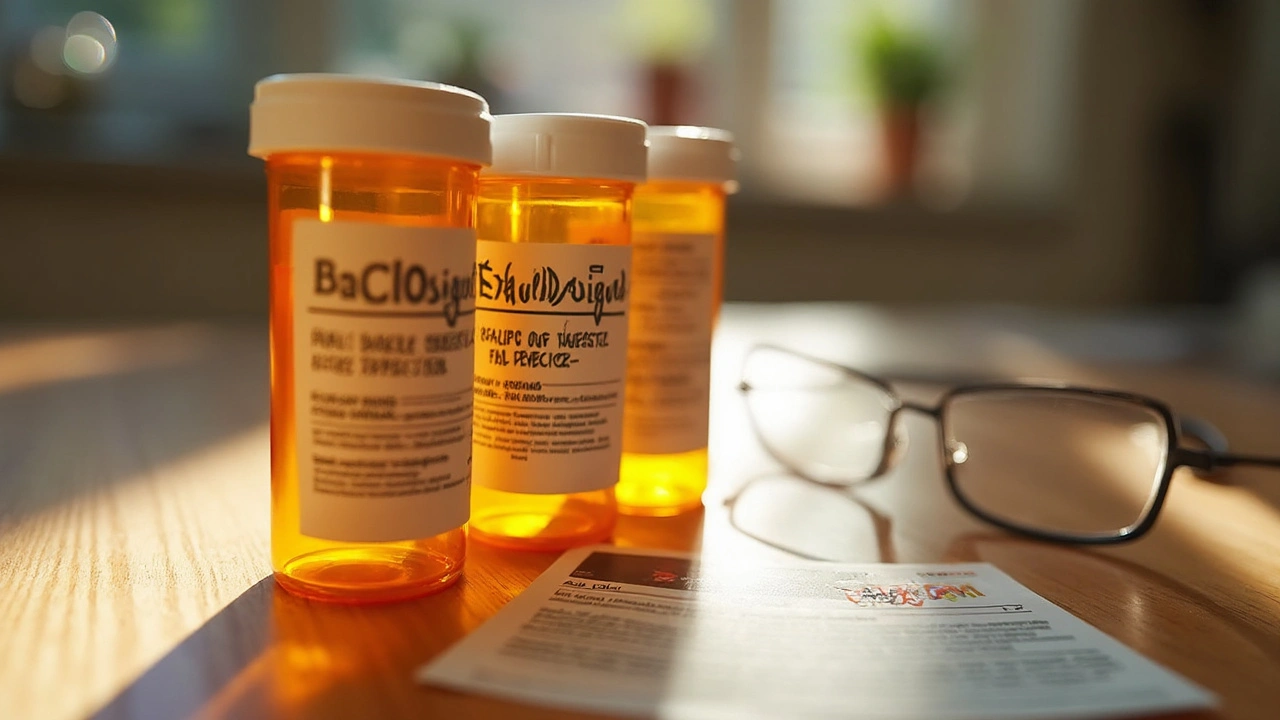
Imagine living with muscle stiffness so intense it interrupts everything—moving, sleeping, even relaxing with family. For folks dealing with spasticity, that’s the daily struggle. Someone mentions Baclosign, suddenly sparking hope for relief that doesn’t involve pain or complicated therapies. But what is Baclosign? Is it just another muscle relaxant, or does it really deliver something special when your muscles seem to have minds of their own? Skepticism is healthy, but let’s be honest: effective options can make the difference between a tough day and one that’s finally manageable. It’s not just about popping a pill—there’s a real story behind Baclosign and baclofen that rarely gets told outside a doctor’s office. Let’s crack open the details and figure out if it’s worth discussing with your physician.
What Is Baclosign? Digging Into Its Use and History
Baclosign isn’t an obscure product hiding in the shadows. It’s actually a branded form of baclofen, a medication that’s been around since the 1970s. Baclofen itself is famous in neurology circles; it’s designed to tackle muscle spasticity, especially in conditions like multiple sclerosis (MS), spinal cord injuries, and, less often, cerebral palsy. If you imagine nerves firing off signals nonstop, causing muscles to tighten uncontrollably, you can get why doctors look to medications like this as an intervention. Baclosign steps up by offering reliable dosage and a formulation that’s meant to go easy on the stomach—something anyone on long-term medications will appreciate.
Now, the name “baclofen” comes up a lot, but what does Baclosign do differently? It’s mostly about branding and the delivery form. Baclosign is marketed in certain countries as a tablet, which you can take orally. It’s regulated, usually by prescription, because its effects are strong and, let’s be honest, not something you want to guess on at the pharmacy. The parent drug, baclofen, first started out in European clinics for MS patients, then trickled into approval in the US and across Asia. The medical community appreciated its relatively low habit-forming potential compared to older muscle relaxants. Baclosign’s popularity has risen because of well-documented results and better patient tolerance.
If you’re researching muscle relaxants, you’ll notice baclofen keeps popping up as “the gold standard” for spasticity. Doctors like it because it targets the source—a neurotransmitter called GABA (gamma-aminobutyric acid)—rather than just sedating all the muscles in your body. Baclosign, as a branded option, jumps in where generics left some users wanting more reliability or clarity about their medication’s origin. In everyday life, people using this brand have reported more consistent results, especially those sensitive to inactive ingredients. That might sound minor until you’re dealing with allergies or intolerances that make other tablets a no-go.
It’s not limited to adults, either. In certain countries, Baclosign is given to children who suffer from severe spasticity, but obviously with special caution and lower doses. The flexibility in dosing has really set Baclosign apart in the pediatric and elderly markets, which is a big win if you’re tired of crushing oversized tablets or splitting awkward pills. The demand from hospitals and rehab centers is no mystery—Baclosign offers a straightforward option when managing muscle tightness in complex neurological cases, and word of mouth from therapists and nurses says it’s trusted far beyond the advertising campaigns you see online.
How Baclosign (Baclofen) Actually Works in the Body
This is where the science gets pretty fascinating. Most classic muscle relaxants dull nerve signals randomly, making you feel groggy before they ever help with muscle tightness. Baclosign’s secret is its use of baclofen, which works by mimicking a chemical messenger that naturally occurs in your brain: GABA. GABA basically tells your muscles to just… chill out. Normally, in spasticity, your muscles ignore those instructions and lock up. Baclosign steps in to boost that signal, letting your muscles get the message loud and clear.
This action isn’t just theoretical—MRI studies from as recently as 2023 have shown a visible reduction in muscle tone and spasms after consistent baclofen use, especially in MS patients. If you’ve ever had a cramp that won’t quit, multiply that by ten and stretch it all day long—that’s what baclofen targets. It calms nerves in the spinal cord, the main highway of muscle commands. This leads to fewer spasms, more relaxed movement, and, for most people, way fewer sleep interruptions. People with spinal injuries have reported feeling like they “got a piece of normal life back,” which is high praise in the world of chronic symptoms.
Here’s an interesting tip: Baclosign kicks in pretty fast, usually starting to reduce spasticity within a few hours of the first dose. But the real magic happens with consistent, prescribed use. Stopping suddenly, though, is a bad idea, as the body can go into withdrawal. Always loop a doctor in on any plans to stop or change the dose. Doctors usually start low and ramp up slowly for one reason—baclofen can drop your muscle tone so much you feel weak or dizzy at first. Give it time and stay hydrated; most side effects melt away with gradual adaptation.
There’s also a growing buzz around off-label uses. Some addiction clinics have experimented with baclofen for cravings, especially related to alcohol. There’s not enough definitive data for doctors to hand it out for this yet, but anecdotal stories keep popping up in news feeds and patient support groups. If you’re hearing chatter about Baclosign helping with anxiety or PTSD, understand that’s still experimental. The main, approved use remains straightforward: controlling spasticity when muscles just won’t cooperate.

Baclosign Dosage, Safety, and Common Side Effects
Baclosign dosages are a balancing act. The “right” amount can look very different depending on your age, diagnosis, and overall health. For adults starting out, doctors usually recommend 5 mg three times daily, gradually inching up to 30-80 mg per day, divided into smaller doses. That prevents your body from getting overwhelmed by the medication’s instant effect. For kids, the doses are much tinier and get adjusted over weeks or months. Don’t make the mistake of thinking more is better—going too high, too fast almost guarantees nasty side effects.
The most reported side effects are drowsiness and fatigue, especially in week one. It’s the price of convincing your muscles to relax after fighting for so long. Other possible issues include headache, dizziness, nausea, dry mouth, or mild confusion (mostly in older adults or those on other medications). Serious side effects don’t happen to most users, but things like breathing trouble, severe weakness, or mood changes mean it’s time to see a doctor or the ER. Long-term use has prompted some specialists to occasionally check liver and kidney function, though Baclosign is generally easy on those organs compared to stronger relaxants.
Important safety tip: never stop Baclosign suddenly. This can lead to withdrawal symptoms—think hallucinations, seizures, or a rapid return of spasticity that feels much worse than before. It pays to taper off under medical guidance if Baclosign isn’t working or you’re moving to a new therapy. Another quirk—mixing Baclosign with alcohol or other sedating meds is a big no. The combined drowsiness is real and can sneak up while you’re at home or, worse, behind the wheel.
One thing that sets Baclosign apart is that it doesn’t tend to build rapid tolerance. That means you’re not constantly having to up the dose just to get the same effect, which is such a relief compared to some heavy-duty painkillers. Still, mark your calendar if you’re due for a dose, especially at the start, because missing even a day or two can reset your progress—nobody wants a rebound spasticity episode just because they forgot. Keep a little pill box nearby and jot down a simple schedule until it becomes second nature.
Who Should (and Shouldn’t) Use Baclosign?
Baclosign isn’t just tossed around to anyone with a sore back. It’s reserved for people with conditions where spasticity really dominates their daily function: multiple sclerosis, certain spinal cord injuries, or intense muscle stiffness following a stroke. Doctors usually try physical therapy first and layer on Baclosign if those exercises aren’t enough. Folks who see the most benefit are those with clear, ongoing symptoms—not just muscle aches after a tough workout. Think of it more like a “quality of life” prescription for when muscle tightness is chronic and disabling.
It’s not a free-for-all—there are groups who need to skip Baclosign or use it with extreme caution. Pregnant or breastfeeding women usually aren’t candidates, since studies on fetus and infant effects are pretty inconclusive. People with kidney disease or epilepsy need careful monitoring; Baclosign can mess with these systems in unpredictable ways. Seniors may get a lot out of this med, but their bodies can be sensitive to dizziness or sedation, so doctors start with even lower doses.
If you’ve got a history of mental health struggles, be upfront—very rarely, Baclosign has triggered mood swings or confusion, especially at higher doses. It can also interact with blood pressure medications, diabetes drugs, and certain antidepressants. Always run your full medication list by your doctor before starting. And if you’re the sort who forgets morning meds or has a life that’s all over the place, set reminders. Baclosign works best when it’s in your system regularly; on-again-off-again dosing can cause chaos for your muscles and mind.
Doctors are sometimes asked about using Baclosign for muscle spasms from injuries or sports, but that’s not the main use—you’ll get more out of regular stretching, hydration, and maybe milder meds. Save Baclosign for those situations where spasticity rules the day and won’t go away just by tweaking your exercise routine. And if your specialist suggests Baclosign, don’t hesitate to ask why it’s being chosen over other options. The answer will tell you a lot about your real needs and treatment goals.

Tips for Using Baclosign and What to Watch Out For
The first rule with Baclosign: communication with your doctor is your superpower. If side effects show up, keep a little notebook or record them in your phone—they’ll help your doctor adjust doses quickly and accurately. Take Baclosign with a meal if it makes your stomach queasy, and space doses out evenly across the day to keep muscle tone under control 24/7. Hydration is underrated: drink plenty of water while on this med, as dehydration can make side effects worse.
Baclosign doesn’t mix well with alcohol or street drugs. If you go out with friends, stick to soft drinks, especially early on. If you get sick (think flu or stomach bug) and can’t keep pills down, call your doctor—missing doses by accident can be more disruptive than you’d expect. Store Baclosign at room temperature and out of reach from kids or forgetful adults, since an accidental overdose in someone sensitive can be dangerous.
Another tip: physical therapy works even better with Baclosign. Once your muscles aren’t fighting you so hard, it’s easier to stretch, move, and regain lost range of motion. If you feel extra weak after starting, lighten your workouts temporarily, but don’t stop moving—gradual activity helps your body settle into the new “relaxed” state without losing overall strength. If driving feels tricky or you get suddenly drowsy, pull over and take a break. Most people adjust within a few weeks, but no one wins by pushing through unexpected dizziness behind the wheel.
If your doctor decides to stop Baclosign, plan the tapering schedule together and stock up on patience—it’s a process, not a race. And if you’re worried about cost or how Baclosign stacks up against generics, ask for a comparison. Some insurance plans prefer one over the other, and sometimes the only difference is in the tablet’s fillers or the way your body reacts to them. Always check the label and make sure you’re getting what your doctor prescribed—swapping between brands without supervision is a recipe for unexpected side effects or lost progress.
Living with spasticity is a full-time challenge, but Baclosign gives a lot of people the space to breathe and move again. Stay curious, track your symptoms, ask questions, and don’t settle for a one-size-fits-all approach. Baclosign isn’t perfect, but for the right person, it’s a game-changer—especially when you know exactly what you’re getting into.




7 Comments
Baclosign, as a branded formulation of baclofen, represents a clinically validated intervention for spasticity, particularly in neurologic disorders such as multiple sclerosis and spinal cord injury. The pharmacodynamic mechanism-GABA-B receptor agonism-results in presynaptic inhibition of motor neurons, thereby reducing excessive muscle tone. Clinical trials, including those published in the Journal of Neurology, Neurosurgery & Psychiatry, demonstrate statistically significant improvements in Ashworth Scale scores with consistent dosing. It is imperative to note that renal clearance is the primary route of elimination; thus, dose adjustment is mandatory in patients with creatinine clearance below 30 mL/min. The absence of hepatic metabolism renders it relatively safe in liver impairment, though sedation remains a dose-dependent adverse effect. Long-term use requires periodic neurological reassessment to prevent tolerance or rebound spasticity upon abrupt discontinuation.
Let me tell you something they don’t want you to know-Baclosign isn’t just for spasticity. The FDA has been hiding the truth since the 90s. Big Pharma bought off the neurologists, and now they’re pushing this ‘miracle drug’ to make people dependent while covering up its real use: mind control. Have you ever noticed how people on it suddenly become calm? Too calm? That’s not muscle relaxation-that’s neural dampening. They’re using GABA to quiet dissent. I’ve got friends in rehab who say they feel like zombies after a month. And don’t get me started on the ‘off-label’ uses… why are addiction clinics suddenly using it for alcohol cravings? Coincidence? I think not. Check the patent filings. Look at the funding sources. This is a covert social engineering tool disguised as medicine.
OMG I JUST STARTED THIS AND I CAN ACTUALLY SLEEP NOW 😭👏 My legs used to lock up at 3am like I was in a horror movie 🙈 I was crying every night from the pain but after 3 days of Baclosign? I slept 7 HOURS. I’m not even joking. My PT cried when she saw me stretch without screaming 🥹 Thank you science 🤗 Also-DO NOT STOP SUDDENLY. I almost did and my muscles went full terminator. Docs were right-taper slow. 10/10 would recommend to anyone suffering 💪💖
I’ve seen patients benefit from baclofen for years, and Baclosign is just one version of it. What matters most is consistency and medical supervision. Many people confuse muscle spasms from overuse with true spasticity, which is neurological. This drug doesn’t help with cramps from dehydration or exercise. It’s meant for conditions where the nervous system is sending wrong signals. If you’re considering it, talk to a neurologist-not a pharmacist or a blog. And if you’re worried about side effects, start low. Most people adjust well. It’s not a magic pill, but it can be a real help when used correctly.
For those unfamiliar with spasticity, imagine your muscles being held in a vice grip by your own nervous system-constant, involuntary, exhausting. Baclosign doesn’t cure it, but it gives you back control. I’ve worked with patients who couldn’t sit in a wheelchair without pain, and within weeks of starting baclofen, they were able to transfer themselves, hold a cup of coffee without shaking, even hug their grandkids without flinching. That’s not just medication-that’s dignity restored. The key is patience: it takes time to titrate the dose, and side effects like drowsiness fade. But the payoff? A life where movement isn’t a battle. And yes, it’s safe for kids too, under careful watch. Don’t let fear stop you from asking your doctor. This isn’t a last resort-it’s a lifeline.
And for those who think it’s just another pill-think again. This is neuroscience in action.
Oh so now we’re recommending a muscle relaxant like it’s a new TikTok trend? 🙄 Let me guess-next you’ll tell me we should all just ‘try it’ like it’s a probiotic. You know what’s funny? The exact same people who scream ‘pharma is evil!’ when a drug is expensive are the first to jump on the bandwagon when it’s ‘clinically proven.’ Meanwhile, no one mentions the 40% of patients who get dizzy enough to fall, or the ones who develop depression on it. And yet, here we are, treating this like a miracle. I’m not saying it doesn’t help-I’m saying don’t romanticize it. It’s a tool. Not a savior. And if your doctor didn’t explain withdrawal risks in detail? Find a new doctor.
I’m a nurse who’s administered this to over 50 patients and let me tell you-when it works it’s life changing but it’s not for everyone 💯 My favorite story? A 72yo with MS who hadn’t held her granddaughter’s hand in 3 years because her arms were locked-after 2 weeks on Baclosign she cried holding her and said ‘I feel like me again’ 🥺 The drowsiness? Real but fades. The withdrawal? Scary AF so never quit cold turkey. I always tell folks to keep a symptom journal and drink water like it’s your job. Also-generic baclofen works just fine for most people unless you’re allergic to fillers. Don’t pay extra unless you need to. And if you’re on other meds? Tell your doctor EVERYTHING. I’ve seen interactions with antidepressants that turned ugly real fast. This isn’t magic. It’s science. Treat it like it.